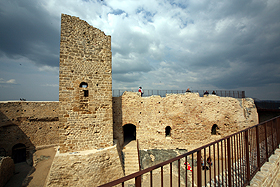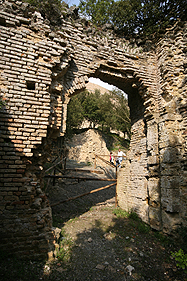Rocca Sillana
 |
 |
| The main front. | The inner ward and the Watchtower of 1067. |
The Rocca Sillana, Rocca di Sillano or Silano is located at the eastern extremity of the municipality of Pomarance (province of Pisa). Coming from Volterra you can reach the fortress following the road for S.Dalmazio (Itinerary of the Ruins, just outside the town), about 1 km. passed the village you'll find the indications for Lanciaia, on the left, and then for Rocca Sillana, on the right. From Florence follow the Motorway Florence-Siena until the exit 'Colle Valdelsa Sud', then follow the indications for Casole D'Elsa, Monteguidi and finally Montecastelli, from here drive toward Pomarance and you will find the indication for the Rocca. Sillano is reachable only by foot after following a path in the wood.
» Where is Rocca Sillana located?
» More Photos [May 2009]
» High Resolution Photos on Flickr
» Photos taken in October 2001
» Other Photos [1998]
» The Parish Church of Sillano
 |
| The most ancient part of the fortress: the watch tower of the 11th century. |
The mighty Fortress of Sillano rises on a hill 530 meters
high and dominate a vast territory that includes the provinces of Siena,
Pisa and Grosseto. This position was always strategically important to
control the valley of the river Cecina and the surrounding minor valleys,
so much that the legend wants to date the origin of the small fortress
in Roman times, during the civil war between the generals Mario and Silla,
and that from Silla himself took its name (Silla>Sillano).
The historical testimonies came up to us confirm that the Fortress
is not so ancient: The tower can be dated year 1067 (is named for the
first time in a document of that year), the buildings of the inner part
of the enclosure about year 1200, while the external bastionated perimeter,
erected at reinforcement of the preexisting wall curtains, can be dated
certainty to the second half of 15th century.
Before reaching the fortress itself we meet other defenses, located around 30 meters below the vertex of the hill. They were the walls of the village that developed around the Rocca, build in bricks, with two Gates, the Porta Volterrana at north-east and the Porta San Rocco at west, this one strengthened with a tower at control of the road that leads under the walls of the rocca.
 |
| San Rocco Gate. |
Reached the the top of the hill we find us under the thick bastionated walls of the fortress. Particular are the four leaning turrets built on the corners of the enclosure and the high curvature of the curtain. The lower parts of the walls are built in stone, the upper in bricks.
Over all stand the ancient nucleus of the fortress: a square shaped stone watch tower, with the gate of access sited at the level of the first floor, now walled but still well visible. Once climbed on the bastions we can easily understand the strategic importance of the Rocca and enjoy a wonderful sightseeing: in the days of clear weather the bird-eye view can space up from here to the sea.
The fortification remained abandoned for centuries. Before the reopening of 18 April 2009, after years of works and excavations, the inner courtyard was invaded by the vegetation and the floor results notably high due to sediment deposits.
In 1985 started the archeological excavations. In the following years the works of restoration bring to the light the internal halls, once used as stores and barracks for the garrison, some ovens and other buildings, also of the village.
In July 2001 the Rocca was endowed with an important system of illumination for the night. Today the complex is again freely visible to the public, each Saturday and Sunday from 3,30 to 6,30 p.m.

The Rocca under restoration, view from Montecastelli Pisano (December
2007)
| » Where is Rocca Sillana
located? » More Photos [May 2009] » Photos taken in October 2001 » Other Photos [1998] » The Parish Church of Sillano |
| Back to Homepage |
| Back to Castles Index |